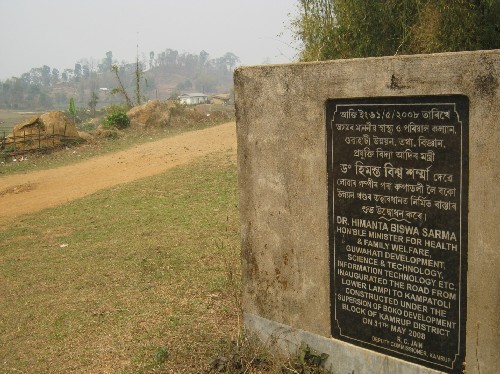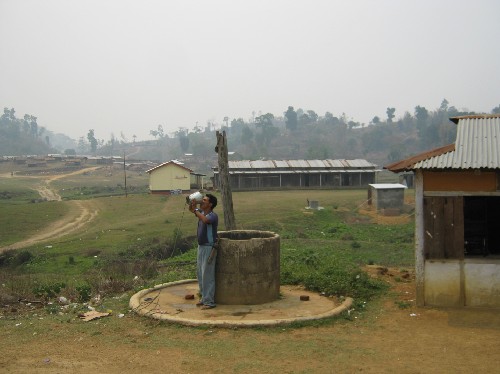With a population of about eleven thousand, mostly Nepalis and Khasis, Lampi falls under the Boko sub division of Kamrup district in Assam. Agriculture and live stock rearing continue to be the mainstay of its people. Jhum or shifting cultivation is still prevalent. However, in the recent years much of Lampi’s forests are gone.
The road condition from Boko to Lampi is beyond description and so there is no regular bus service. People hire pick-up vans when they travel from Lampi Bazar to Boko and vice versa. One has to stand all the twenty kilometers distance. The business center is the Lower Lampi Bazar, with hardly 10 shops around. A marbled inscription constantly reminds the residents the day when the state health and education minister inaugurated the programme of road construction. Arjun Sarma, a local youth from Boko said that a total amount of Rs 12 crore was allotted for the construction project. But five years down the line, it is still the old kuchha road.

Electric posts without cables stand as lonely sentinels by the roadside all the way from Boko to Lampi. From Lower Lampi to Upper Lampi, such posts are seen lying in stockpile. Electricity or no electricity, contractors meanwhile collected their cheques issued under the scheme--Rajiv Gandhi Gramin Vadyutikaran Yojona (RGGVJ)--alleges Dipak Sarma, a youth leader. Same is the story with the rural water supply scheme.
The Lower Lampi Middle English School established in 1988 with 65 students awaits provincialization. Chandra Sarma, the headmaster said that he and his six assistant teachers are yet to get their salary. It is been two decades now that these six teachers are providing services without any salary. After passing out the VIIth standard, students have to move out of Lampi to Boko or other distant places for their admission in a high school. Omprakash Shirish is another teacher working in Brindaban Lower Primary School at Makaribari village in Lampi for 27 seven years without any government assistance.

The apathy shown by the Assam Government has meanwhile encouraged a section of local leaders to be more inclined towards the Meghalaya administration. This camaraderie grew in recent times so much so that Meghalaya started calling Lampi as a part of its own territory and asked the Khasi community of Lampi to cast their vote in the Meghalaya state election. This has been the reason for the turmoil in Lampi a few years back. Meanwhile, the bordering neighbor started grabbing land in Lampi .Vast stretches of forestland cleaned overnight and the neighboring administration started implementing schemes meant for Meghalaya in Assam’s Lampi to attract the Khasi community’s vote. The Meghalaya Government went a step further and started issuing land pattas to the people living along the border. Now they are trying to woo these people with basic facilities like electricity and water.
It is to be seen in the near future, whether it is loyalty to the state or electricity and drinking water that wins over the residents of Lampi!




Add new comment